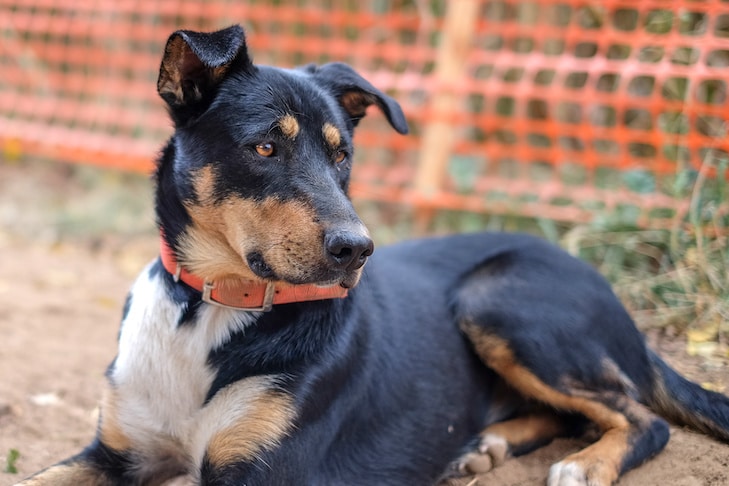You may have only heard about dogs getting rabies from the classic kids’ book “Old Yeller.” But rabies in dogs is still very much a threat to pets who are unvaccinated. By learning about rabies, you can keep your dog safe from this deadly disease and help ensure they live a happy, healthy, and long life.

Akita Inu
Akita Inu
Os cachorros japoneses têm, sem dúvida, algo de especial no seu olhar e na sua forma de ser. Talvez seja por isso que encontramos tantos








Rabies is a zoonotic disease, meaning it’s infectious and transmitted from animals to humans and vice-versa. Rabies in dogs has high fatality rates. Once symptoms become noticeable, there is almost a 100% chance the disease will result in death.
“If a dog is bitten by an infected animal, the chances of becoming infected are very high,” says veterinarian Dr. Corinne Wigfall. “The infection period can vary, but is usually two to four weeks, and owners are sometimes not aware that their dog has been bitten, increasing the risk of other dogs and people becoming infected also. The main cause of human deaths from rabies is being bitten by dogs.”
Dr. Wigfall also says that the chance of survival for infected dogs is very low. There have been a few reported cases of dogs surviving rabies. However, it’s suggested that the amount of rabies virus in the saliva when the dog was bitten was low, reducing the load of virus transmitted.
In most cases, a dog will die as a result of rabies because there is currently no treatment, according to veterinarian Dr. Jamie Richardson. If rabies is discovered, the dog will likely be euthanized.
How Do Dogs Get Rabies?
Since most dogs in the United States are vaccinated against rabies, it’s not likely that your dog will contract it from another dog. Dr. Richardson says that the highest risk comes from wild animals, such as skunks, foxes, raccoons, and bats.
“The most common way dogs become infected is via a bite from the rabid animal, as they secrete large amounts of the virus in their saliva,” she says. “However, rabies can also be transmitted if the infected animal’s saliva comes into contact with a scratch, an open wound, or areas like the mouth, eyes, or nose.”
Rabies Symptoms in Dogs
Rabies will affect your dog’s nervous system. Dr. Wigfall says that signs of rabies in dogs can include major behavioral changes, like becoming very agitated, easily stimulated, fearful, and aggressive. Some dogs may attempt to bite, show their teeth, bark, and react violently and aggressively in any situation. As the disease progresses, seizures in dogs, dog paralysis, and eventually death will occur.
What to Do if You Think Your Dog Has Rabies
If you believe your dog has rabies, Dr. Wigfall advises isolating your dog immediately to a kennel or room. It’s a good idea to not have any further contact with your dog until you call your veterinarian.
“They will be able to advise on your next steps and may even choose to transport your dog to an assessment facility themselves to minimize the risk of injury to others. As the disease is zoonotic, extreme caution and care must be taken when handling dogs suspected of having rabies.”
Dr. Richardson says that you should never come in contact with your dog’s saliva if you suspect rabies transmission has occurred. Once you isolate your dog, it’s critical to disinfect any areas your dog may have infected, particularly with saliva. You can use a 1:32 dilution (4 ounces to a gallon) of household bleach solution to inactivate the virus quickly.
If you see a possibly rabid animal bite your vaccinated dog, Dr. Richardson says you should take the dog to your veterinarian immediately for a booster vaccine. “This helps to strengthen the dog’s immunity to rabies and reduces the chances of the virus developing. Do not wait for symptoms, as it will be too late.”
Preventing Rabies in Dogs
Thankfully, if you vaccinate your dog regularly against rabies, you can protect them with the rabies shot for dogs. Richardson says to keep in mind that most states require dogs to get rabies vaccines. Your puppy will get the first installment of the rabies vaccine for dogs between 12 to 16 weeks of age. They’ll then receive boosters at regular intervals.
How often do dogs need rabies shots? They’ll usually receive a booster every year or every three years. The frequency will depend on your state laws.
Additionally, Dr. Richardson suggests not allowing your dog to roam off the leash, especially in wooded areas with wild animals. Avoid contact with unknown animals that are dead or alive, especially animals that display wild behavior or that seem unusually tame, unafraid of humans, or friendly. Feeding your dog indoors and animal-proofing your trash can also help prevent your dog from getting rabies.